8:00 - 17:00
Opening Hour: Mon - Fri
Emergency department visits have been increasing steadily for more than 20 years. According to the Centers for Disease Control and Prevention (CDC), there were 144.9 million emergency department (also commonly referred to as emergency room) visits in 2017, roughly a 50 percent increase from 1995.
But it’s not just population growth that’s accounting for the spike. The rate of emergency room visits has grown too, reaching 445 visits per thousand residents in 2017 compared to 360 in 1995.
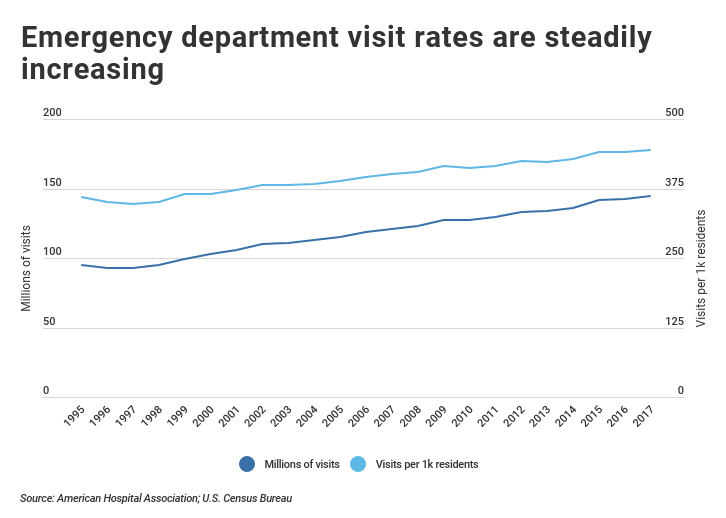
Despite the label, most emergency department visits are for non-emergency care. Triage statistics from the CDC reveal that less than 1 percent of emergency room visits require immediate attention and only 9.9 percent are categorized as emergent. While approximately a third of emergency department visits are deemed urgent, nearly another third fall into less-than-urgent categories.
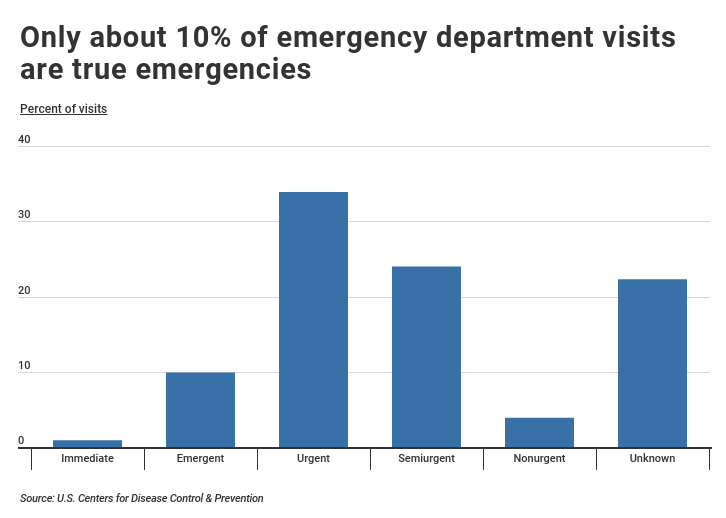
With the steady rise in emergency department visits, many patients are experiencing longer wait times as well. In general, emergency rooms do reasonably well when it comes to getting people seen initially. Nationwide, over 40 percent of patients are seen by a physician, nurse, or physician assistant within 15 minutes of checking in. However, 14 percent of visits have an initial wait time exceeding one hour and approximately 2 percent of patients leave the hospital without being seen at all.
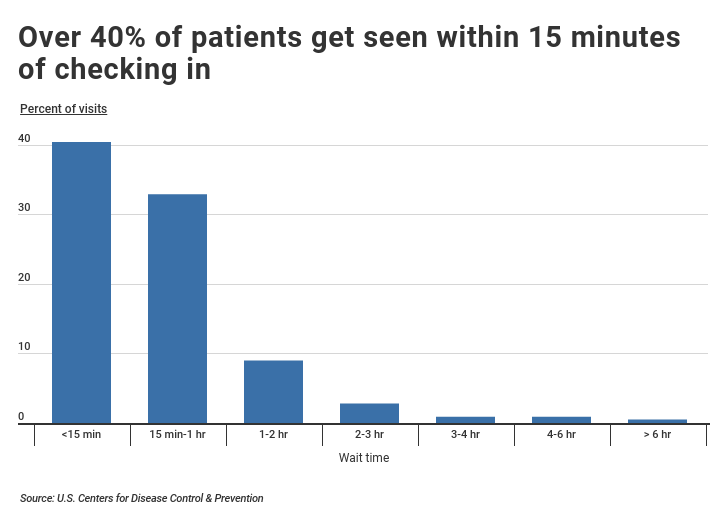
While initial screening times in the emergency department can be relatively quick, the total time spent waiting for treatment, discharge, or to be admitted to the hospital for further treatment is significantly longer. Nationwide, patients who are ultimately admitted to the hospital spend a median of 103 minutes waiting in the emergency department for an inpatient room after the ER doctor decides to admit them.
People who are not ultimately admitted as inpatients spend a median of 141 minutes in the emergency department before leaving from the visit.
To find which states have the longest emergency department wait times, our researchers here at AutoInsurance.org analyzed data from the CDC and the Kaiser Family Foundation. Our researchers ranked the 15 states with the longest median wait times for patients that are ultimately admitted to the hospital as inpatients.
Our researchers also included data on discharged patients and patients who decide to leave before getting seen. The longest wait times are clustered in the Northeast, while the Midwest has shorter wait times.
Table of Contents





TRENDING
We can help you find the right insurance regardless of your financial situation. Looking for an anonymous car insurance quote? We can do that. Interested in finding less expensive full coverage auto insurance? We can help there too.








DID YOU KNOW?
Age is one of the biggest factors in determining auto insurance rates, especially if you are getting auto insurance for a 16-year-old. Lookup auto insurance rates by zip code to see what you might pay.


To identify states with the longest ER wait times, our researchers ordered states by the median time admitted patients spent waiting for an inpatient room after seeing a doctor. In the event of a tie, the median time discharged patients spent in the emergency department before leaving the visit was used.
Emergency department wait times nationally, and for each state, were obtained from the Hospital Compare dataset from the CDC. Emergency department visit rates were obtained with permission from the Kaiser Family Foundation.
Rates of emergency department utilization by income were obtained from the CDC’s National Health Interview Survey. All other information on the utilization of emergency departments were obtained from the CDC’s National Hospital Ambulatory Medical Care Survey. The top ten most frequently prescribed drug categories were obtained from records of emergency department drug mentions, which are medications given in emergency departments or prescribed at discharge.
Emergency department visits are dominated by lower-income groups.
According to the CDC, nearly 30 percent of visits are for patients below the poverty line, even though Census Bureau data shows that people below the poverty threshold account for just 13.1 percent of the population.
A combination of factors, including reduced access to health insurance and preventive care, contribute to this trend.
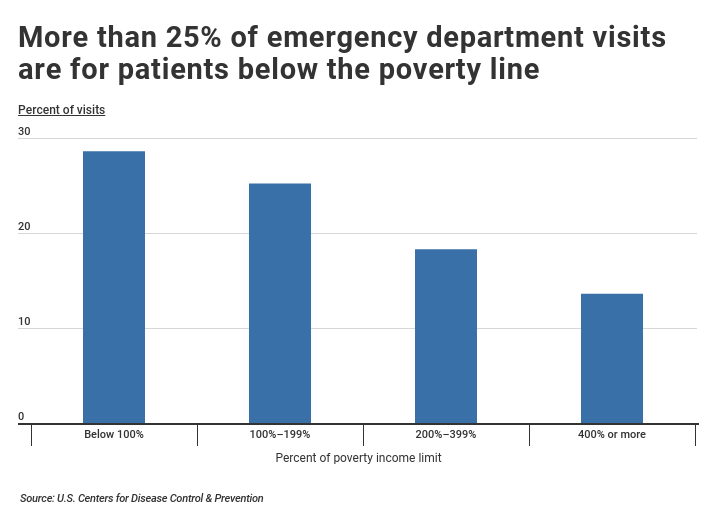
RELATED
Every state in the U.S. requires that its drivers carry car insurance. Fortunately, government auto insurance is an option that helps low-income families get the minimum insurance they need to drive. Learn more here: What is Government Auto Insurance.
Furthermore, when it comes to the outcomes of an emergency room visit, many patients are prescribed medication to manage their ailment. Painkillers are the most frequently prescribed drug by a large margin, accounting for more than a quarter of the prescriptions.
These medications, which the CDC classifies as “analgesics,” include narcotics and nonsteroidal anti-inflammatory drugs. However, growing concerns about the opioid epidemic have brought the practice of prescribing painkillers in the emergency room under intense scrutiny.
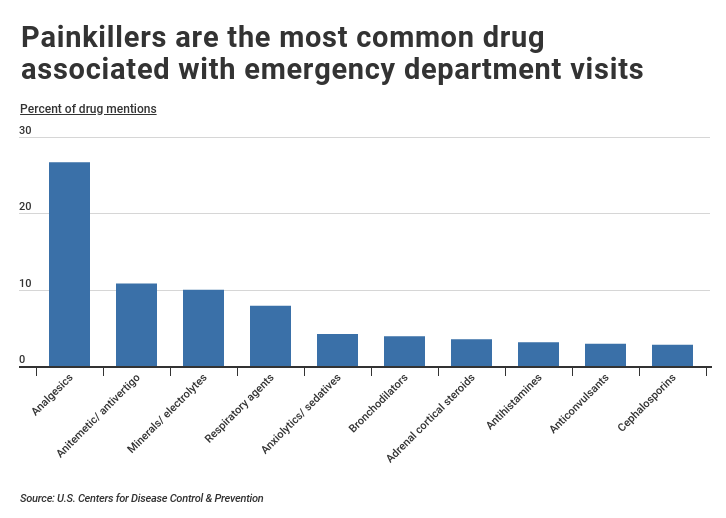
Overall, there is no single answer to reducing emergency department wait times, non-emergency visits, and the overall number of visits in a year. However, improving access to preventive care, especially among low-income communities, is a step in the right direction.
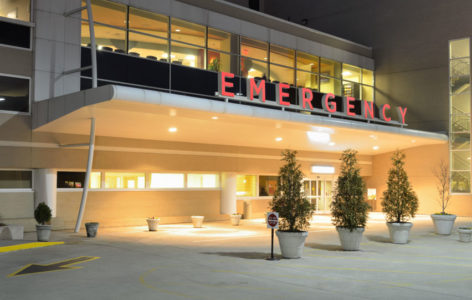
| State | Wait Time (Admitted Patients) | Wait Time (Discharged Patients) | Unseen Patient Percent | ER Visits (Per 1,000) | Rank |
|---|---|---|---|---|---|
| District of Columbia | 286 | 236 | 3 | 698 | 1 |
| Delaware | 153 | 186 | 4 | 467 | 2 |
| New York | 153 | 178 | 2 | 433 | 3 |
| Maryland | 152 | 210 | 3 | 392 | 4 |
| Connecticut | 152 | 159 | 1 | 480 | 5 |
| New Jersey | 150 | 166 | 2 | 431 | 6 |
| California | 150 | 160 | 2 | 341 | 7 |
| Rhode Island | 147 | 185 | 3 | 390 | 8 |
| Massachusetts | 131 | 173 | 2 | 485 | 9 |
| Hawaii | 131 | 122 | 1 | 317 | 10 |
| Alaska | 121 | 125 | 1 | 551 | 11 |
| Vermont | 119 | 145 | 1 | 514 | 12 |
| New Hampshire | 115 | 147 | 2 | 498 | 13 |
| Nevada | 115 | 145 | 1 | 323 | 14 |
| Pennsylvania | 115 | 142 | 2 | 514 | 15 |
| Washington | 112 | 182 | 3 | 398 | 16 |
| New Mexico | 111 | 148 | 3 | 475 | 17 |
| Arizona | 110 | 168 | 2 | 319 | 18 |
| North Carolina | 109 | 155 | 2 | 473 | 19 |
| Georgia | 108 | 140 | 2 | 455 | 20 |
| Florida | 107 | 144 | 1 | 438 | 21 |
| Michigan | 105 | 141 | 1 | 511 | 22 |
| Oregon | 99 | 146 | 2 | 378 | 23 |
| Louisiana | 99 | 120 | 2 | 618 | 24 |
| Texas | 98 | 133 | 2 | 422 | 25 |
| South Carolina | 96 | 145 | 3 | 513 | 26 |
| Maine | 96 | 137 | 2 | 486 | 27 |
| Illinois | 95 | 146 | 2 | 448 | 28 |
| Ohio | 93 | 132 | 1 | 611 | 29 |
| Tennessee | 91 | 140 | 1 | 519 | 30 |
| Missouri | 88 | 135 | 2 | 504 | 31 |
| Virginia | 88 | 131 | 1 | 423 | 32 |
| Kentucky | 85 | 146 | 2 | 580 | 33 |
| Indiana | 83 | 122 | 1 | 514 | 34 |
| Colorado | 80 | 131 | 1 | 355 | 35 |
| Alabama | 79 | 126 | 2 | 479 | 36 |
| Arkansas | 76 | 121 | 2 | 496 | 37 |
| Oklahoma | 75 | 108 | 2 | 492 | 38 |
| West Virginia | 73 | 128 | 2 | 648 | 39 |
| Idaho | 70 | 119 | 1 | 394 | 40 |
| Minnesota | 69 | 111 | 1 | 372 | 41 |
| North Dakota | 68 | 97 | 1 | 538 | 42 |
| Mississippi | 67 | 111 | 2 | 604 | 43 |
| Montana | 63 | 115 | 2 | 480 | 44 |
| Utah | 62 | 124 | 1 | 358 | 45 |
| Nebraska | 62 | 106 | 1 | 420 | 46 |
| Wisconsin | 61 | 124 | 1 | 429 | 47 |
| Iowa | 60 | 113 | 1 | 436 | 48 |
| Wyoming | 58 | 120 | 1 | 438 | 49 |
| Kansas | 55 | 110 | 1 | 418 | 50 |
| South Dakota | 46 | 109 | 1 | 375 | 51 |
Cheap Auto Insurance / Features